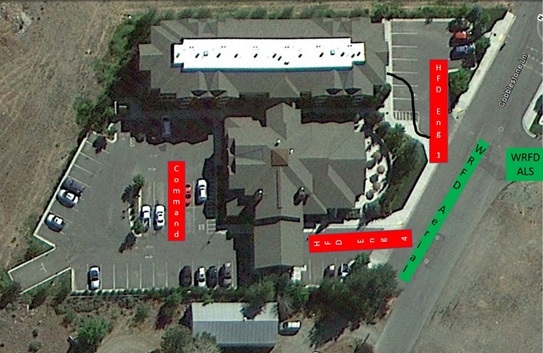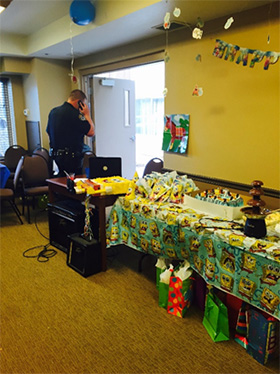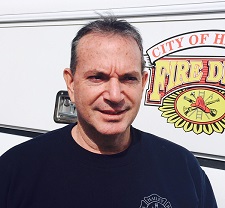
By Craig Aberbach
On March 7, 2015, the Hailey (ID) Fire Department (HFD) received a call for a smoke detector activation at a hotel (Figure 1) at 17:00:46 from the county’s communications division, and that was relayed from the alarm monitoring company. The call was dispatched at 17:01:08, with the first units going en route at 17:02: 00 and arriving at 17:04:52.
Figure 1. Layout of the Hotel with Crew Positioning.

Being a smoke detector activation call, the first-responding officer asked dispatch to contact the hotel and see if they could provide additional information. Dispatch reported back that there was no answer on call back, so the officer requested that the call be upgraded to a structure fire until more information could be obtained. The structure fire response would also have auto aid responses from two of Hailey’s neighboring departments, which included an aerial device and an advanced life support ambulance from the Wood River (ID) Fire Department (WRFD), an engine from the Bellevue (ID) Fire Department (BFD), and two engines and a command vehicle from HFD.
The first responder on scene was a chief officer in a command vehicle. The initial report confirmed the address and reported visual and audible warning devices sounding. The building was still occupied with a large gathering of occupants under the carport on the A side of the structure. Command was set up on the A and B sides in the parking lot.
At this point, we assumed that this was just your typical false alarm with a partially occupied building and no smoke or any report of smoke. The incident commander (IC) entered the building; as he made his way to the front desk, he began asking all guests in the lobby to evacuate. He contacted the manager on duty for any additional information, asked if all employees were accounted for, ensured they were being evacuated, and then requested a printout of all hotel guests and a master key for all hotel rooms. The hotel manager reported that someone had burned popcorn on the first floor. Our initial and only report was that it was a smoke detector on the third floor. The IC continued to check the first floor to ensure that all were evacuated with audible and visual alarms still detected throughout the building. Guests were still in the fitness center and the indoor pool area, where they had to be ordered to leave. Many kids, part of a children’s party in the meeting room, were still inside the building.
As the first-arriving engine made it to the scene, the officer was assigned interior operations with a crew of three and then directed the engine to standby at the fire department connection. Interior operations was also given the list of hotel guests, indicating which rooms were occupied. The WRFD ambulance was staged at the nearest intersection, and the ladder was assigned to the A and D sides.
As interior search began, the IC remained at the command post and advised dispatch of the actions taking place. An additional chief officer arrived from the Sun Valley (ID) Fire Department and was assigned as safety officer. The crew from the aerial truck was assigned to assist with a floor-to-floor, room-to-room search of the building. The auto aid engine from the BFD was assigned to stage at the HFD if additional resources were needed or if a separate call for service was dispatched. In addition, another response crew from HFD was standing by at the station.
It was remarkable how many rooms were still occupied while all alarms were sounding. During the search of the main floor meeting room (where kid’s party was taking place) (photos 1, 2), several propane tanks and an outdoor double burner were discovered (photo 3).


(1) Photos by author. (2)

(3)
When crews made it to the third floor through a stairwell, they encountered hotel guests who were asked to leave until we could give the hotel an all-clear. On exiting the structure through the hotel entrance, guests reported to firefighters that they had witnessed juveniles pull a fire alarm actuator. At about the same time, interior crews made it to the alarm enunciator panel and confirmed that it was a pull station, not a smoke detector, which activated the alarms. The guests never called or informed any hotel staff what they witnessed until they exited the building at least 10 minutes after alarm activation.
Forty-four of the hotel’s 64 rooms were occupied as well as the meeting room occupied by nonguest party goers.
Events leading up to this alarm which helped make it a success and some of the challenges faced follow:
- On the Saturday prior to the alarm, a local firefighter I class was concluding at HFD, placing additional firefighters in close proximity to the HFD and WRFD.
- With little information received from the alarm company, the initial responding officer upgraded the call to a structure fire.
- An early request for police response was made to help with hotel guest accountability and traffic control.
- An early request for fire inspector was made to help deal with potential hazards associated with burner and propane tanks inside meeting/party room.
- A good accountability system was in place to assist with the multiagency response.
- In 2014, Blaine County, Idaho, fire chiefs established shared standard operating guidelines for emergency operations.
- Joint department weekly training between HFD, WRFD, and BFD with shared auto aid agreements bettered prepared all agencies for this type of response.
Challenges
- Little or bad information was reported by the alarm company to dispatch.
- The congested parking lot from the occupancy and a party hampered apparatus placement.
- On arrival at the hotel, there was conflicting information regarding burnt popcorn on first floor, which turned out to be a nonfactor.
- A large number of guests and hotel employees did not evacuate the building.
- Discovering propane tanks and burners in a meeting area that were ready to be used indoors!
- No smoke detector activation as reported.
Overall, there were many small, individual issues that could have derailed the efficient and effective operation on this call. The call was a success because we let the firefighters do their jobs and looked at the big picture. After the initial report of burned popcorn, we could have cancelled all units and never searched the building. If we simply went to the third floor (the location of the initial report), we would have never found the propane grill being readied for use. The grill—placed at the back corner of the room—would have most likely ignited the walls. If we didn’t do our part as expected and there was an actual incident, the guests in the pool and gym areas would have been jeopardized because the meeting room was right across from that area.
This call was a great example of due diligence. As firefighters, we have a responsibility to not take shortcuts that may lead to missing important safety issues. Every time we leave our station, we must survey our surroundings and take action when it comes to life safety.
 Craig Aberbach is the chief of the Hailey (ID) Fire Department.
Craig Aberbach is the chief of the Hailey (ID) Fire Department.

